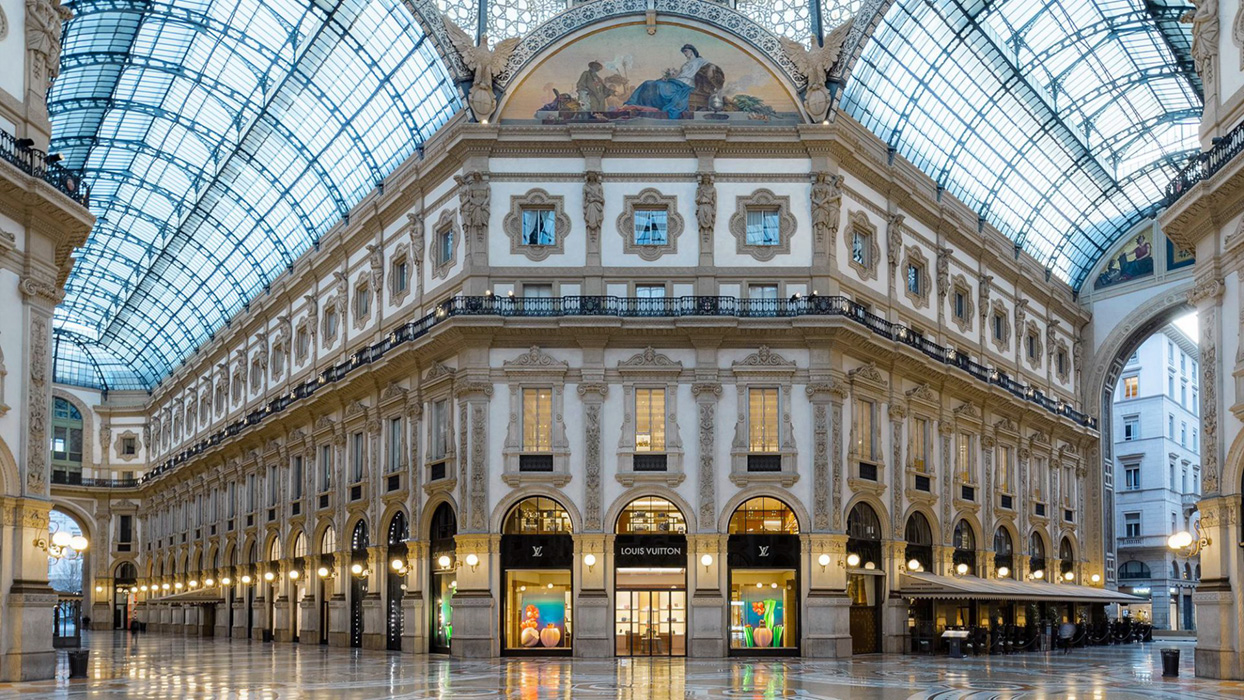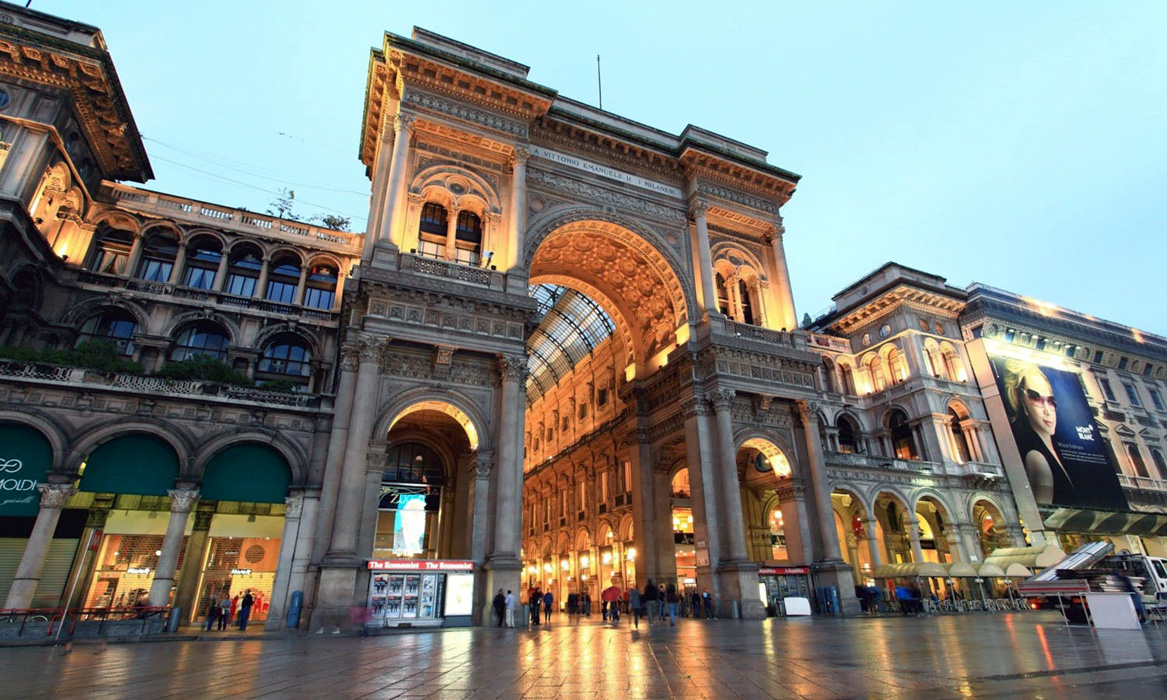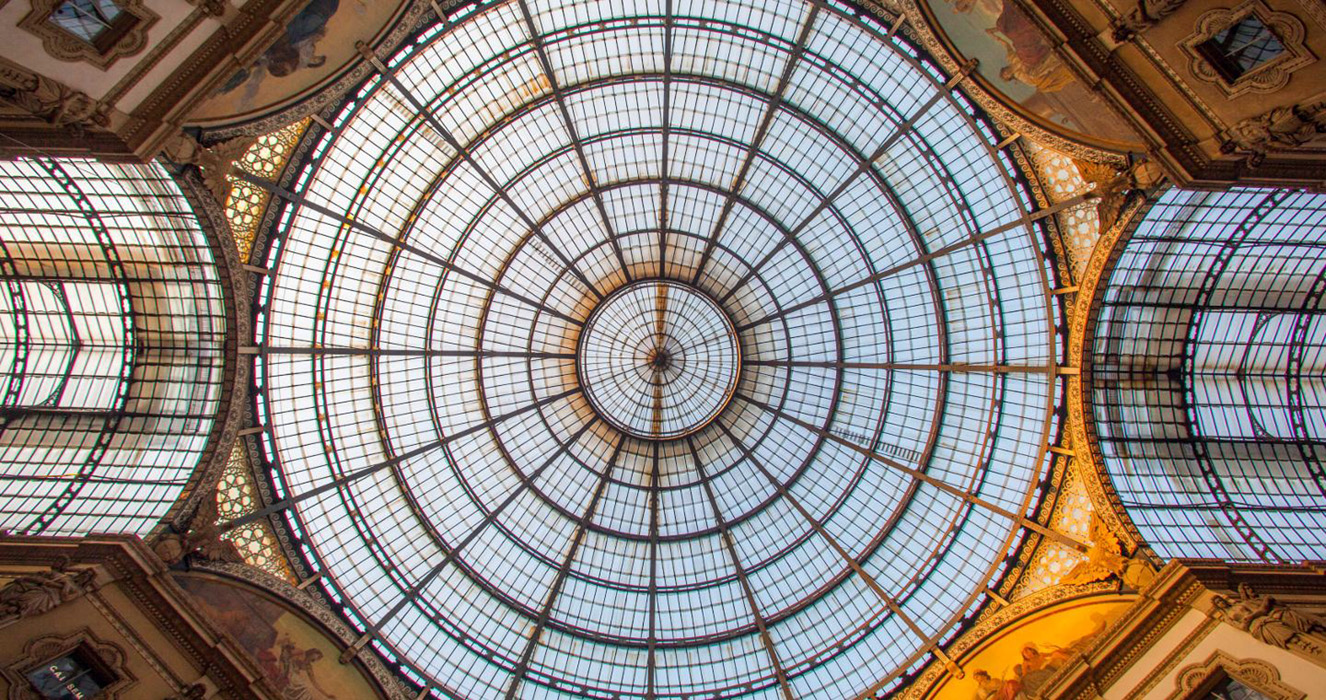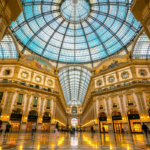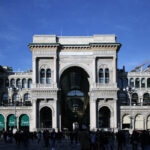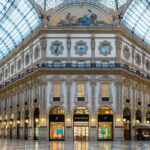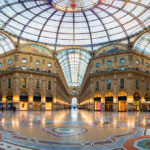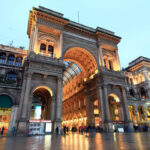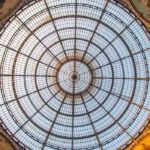Milan – The Galleria Vittorio Emanuele II
The Galleria Vittorio Emanuele II is a commercial gallery in Milan that connects Piazza Duomo to Piazza della Scala as a covered pedestrian street. Since its opening, it has been a meeting place for Milanese bourgeoisie due to the presence of elegant shops and places, so much so that it was nicknamed the “salon of Milan”: built in the neorenaissance style, it is among the most famous examples of European iron architecture and represents the archetype of the 19th-century commercial gallery. It is simply called “the Gallery” by the people of Milan and is often considered one of the first examples of a shopping mall in the world.
The presence of covered passages in Milan, intended as arcades, dates back to medieval times: in the 13th century, Bonvesin de la Riva noted in his Wonders of Milan the presence of about sixty covered arcades in the city, then called “coperti.” With the advent of the Sforza family first and then Spanish domination, the arcades were progressively demolished until few survived, including the Coperto dei Figini, which paradoxically was demolished for the construction of the Vittorio Emanuele II Gallery. On the other hand, Milan was the first city in Italy and the Austrian Empire, with the De Cristoforis gallery, to have a passage inspired by what was happening in the main European capitals where covered passages with iron and glass roofs for commercial purposes were being built, such as the Galeries Vivienne in Paris and the Burlington Arcade in London. However, the De Cristoforis gallery was an isolated case, and for thirty years, it was the only gallery in Milan, so the city presented itself to the unification of Italy without the tradition of arcades and covered passages more typical of cities like Turin and Bologna.
The idea of a street connecting Piazza Duomo and Piazza della Scala came as a result of one of the many debates that had been animating the city for some time, promoted in 1839 by Carlo Cattaneo, about the remodeling of the area in front of the Milan Cathedral, then smaller and irregular and deemed by many unworthy of the city’s cathedral. The area’s roads were also tortuous and intricate, based on narrow streets of medieval origin and becoming less and less manageable as city traffic grew. The idea of dedicating this new street to King Vittorio Emanuele II came, on the one hand, as a consequence of the enthusiasm for independence from Austria, but on the other hand, the city council also hoped to obtain more easily the permits for the expropriation of the buildings necessary for the work, which were then obtainable through royal decree. However, the initial municipal guidelines for the project did not provide for a covered passage, but rather a simple porticoed street. In the 1859-1860 biennium, three royal decrees were signed, which the city council was waiting for: one for the expropriation of the buildings to be demolished, one for the demolition of the Coperto dei Figini and Rebecchino, buildings that then occupied the current Piazza Duomo and had to be demolished to give the square a nobler appearance, and a final decree to authorize a lottery aimed at raising the necessary funds for the construction of the new street.
After obtaining the permits for the expropriations, on April 3, 1860, the Municipality of Milan announced the construction competition for the new street, whose projects would be evaluated by a specially established commission. Despite the controversy over the poor advertising of the competition organized by the municipality, a very high number of projects were submitted to the first call. Among all of them, 176 were selected by the commission and exhibited at the Pinacoteca di Brera. The commission did not decree any winner of the competition but formulated more precise indications about the forms of the project, arriving at the initial idea of a covered passage and announcing a second competition in February 1861. Eighteen projects arrived at the evaluation stage for the second project, but again, the competition did not have a winner, and four compensations were given to the most meritorious projects: the architects Davide Pirovano and Paolo Urbani were mentioned, respectively for the use of Palladian-inspired architecture and eclectic architecture that fused Lombard and Venetian forms, both considered unsuitable for the cathedral’s context. More appreciated, albeit without resulting in winners, were the projects of Gaetano Martignoni, who proposed a gallery in the shape of a Greek cross to connect the two squares, and Giuseppe Mengoni, who proposed a road inspired by 14th-century municipal palaces in the first project proposed.
Therefore, the third and final competition was announced in 1863, in which only eight projects were evaluated, three on invitation from the commission, and five presented spontaneously. The winner was Giuseppe Mengoni, on the condition that he was available for the revision of some parts of the project. Initially, Mengoni had planned a single gallery, which would then be transformed into the actual project of a cross gallery, along with a series of small stylistic details that led to the definitive forms. The project also involved the construction of a porticoed palace facing Piazza Duomo and a Royal Loggia in front of the entrance to the gallery, communicating with the long sleeve of the Royal Palace, but these designs were never realized.
The construction contract was awarded to the British company City of Milan Improvements Company Limited, and the ceremony for the laying of the first stone by King Vittorio Emanuele II took place on March 7, 1865. The works, excluding the triumphal arch entrance, were completed in less than three years, and the official inauguration of the Gallery followed by the King. The actual completion of the works did not occur so smoothly – in 1869, the contracting company failed, forcing the municipality to acquire the Gallery for the sum of 7.6 million lire of the time. The actual conclusion of the works would only take place in 1878 when the entrance arch and the northern porticos of Piazza Duomo were completed. Giuseppe Mengoni, however, could not see the full opening of the Gallery as he fell from scaffolding during an inspection, although according to some reports, it was an actual suicide.
A few years after its first opening, the Gallery earned the nickname “salon of Milan,” becoming the seat of the city’s bourgeois life that enjoyed frequenting the new elegant shops, but especially the restaurants and cafes. Among the places that settled there at the time and are still existing are the Campari Cafe, the Savini Cafe – founded as the Gnocchi Cafe – and the Biffi Cafe. The Gallery was also at the center of the technological innovations of the time and was initially illuminated with gas: for the ignition of the lamps on the octagon, an automatic contraption consisting of a small locomotive that progressively lit the lights, was used, called “rattìn” (“mouse” in Milanese dialect). Watching the automatic ignition procedure had become almost a ritual. This ritual continued until 1883 when the illumination of the Gallery was switched to electric light, although for three years, the Gnocchi Cafe had already been using this, for the times, new form of illumination.



